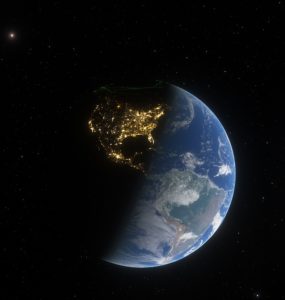And now it is Midwinter, and I am here to tell you again the same story, the story I tell you each year on this darkest night. It never grows old (I don’t think so, anyway), for it is the story of our home, our planet, our place in this vast mysterious universe. It is a story rooted in science and perhaps in divinity and certainly in celestial mechanics: at about 5:02 AM––early Monday morning here in Lake Worth, which is in Eastern Standard Time now––the planet will reach its solstice moment. The sun, which has been tracking further and further south on the horizon since last June, appears to stand still for a few days––tracking no farther south. And herein lies the etymology of the word solstice: sol = sun; stice = static, stand still. By Tuesday, already, things will begin to shift the other way, and we will be on our slow and patient way toward summer.
Ah, but that is already the future, and tonight it is the present we are concerned about. It is the Midwinter solstice in the Northern Hemisphere: our longest night of the year, our shortest day. Out of these darkest nights come our deepest joys: all of the celebrations of Midwinter that have come to pass and that are on the horizon. The feasts of St. Nicholas, of Santa Lucia, and of Our Lady of Guadalupe; the eight nights of Chanukah; the ever increasing light of Advent, and still ahead, Christmas Eve and Christmas Day and the Twelve Days of Christmas that follow. These are days and nights of adding our light to the sum of light, of understanding that joy comes out of our countering what is dark with light.
The science behind all this is the simple fact that our planet rotates on its axis at a tilt of about 23.5 degrees. As we spend our year revolving around the sun, the pole that is tilted toward the sun experiences spring and summer, the pole that is tilted away experiences autumn and winter. Were it not for that 23.5 degree tilt, we would have no seasons. The round of the year would not be the same, would it? We would lack that constant rearrange––each day slightly different from the one before and the one to come. Experienced day by day, the change is not terribly noticeable. Stack them up and view them as a year, though, and our world turns upside down with change. Many of us are not fond of change (I can be like that), and yet our planet is constantly in flux. Nothing stays the same, and yet nothing really changes. That is the paradox of our round of the year, and that is the paradox of a tilted axis, too. It is sublime, and divine, and it is the beauty of physics and science. How wonderful (how completely filled with wonder) is that?
Image: Earth daylight distribution on the December 2020 Solstice (Northern Winter; Southern Summer) as seen on w:SpaceEngine. This file is licensed under the Creative Commons Attribution-Share Alike 4.0 International license.
